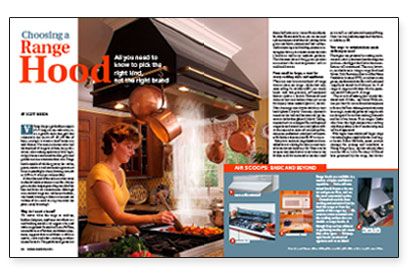Choosing a Range Hood
All you need to know to pick the right kind, not the right brand.

Synopsis: This article explains why ranges and cooktops require range hoods for ventilation, describes the differences between the various types and styles of hoods and blowers, and tells how to size a ventilation system and design the installation. Included is information on supplying makeup air and a sidebar on sizing ductwork.
Viking’s largest gas kitchen range is a 5-ft.-long colossus with six burners, a griddle, and a char-grill that collectively can throw off 123,000 Btu of heat—enough to warm a small house in a cold climate. Not many at-home cooks will tax that kind of range to its limit, but professional-style cooking appliances with high output burners and amenities like grills and griddles are more common than ever. Range hoods capable of whisking away the smoke, grease, moisture, and combustion gases must be correspondingly robust, drawing as much as 1200 cu. ft. of air per minute (cfm).
At the other end of the scale are what many residential cooks continue to use: four-burner gas or electric ranges generating one-third the heat and fewer air contaminants. Although any standard range can smoke up a kitchen, vent hoods drawing as little as one-tenth the volume of air—and costing one-tenth the price—may be enough.
Why do I need a hood?
No matter what the range or cooktop, kitchen designers, appliance manufacturers, and building scientists all suggest it be used with a range hood. Research at Broan-NuTone, a manufacturer of kitchen-ventilation equipment, suggests that in addition to obvious spatter, steam and odors, cooking produces unseen hazards. Tiny particles of grease less than a half-micron in size can float in the air for days. Electrostatic forces, air currents, and a phenomenon called thermal plating drive grease into fabrics, cabinets, and wall surfaces. And as more rigorous building practices create tighter houses, air contamination becomes a health as well as an aesthetic problem. That’s because those drifting grease particles are nutrients for microorganisms such as mold and bacteria.
From small to large, a vent for every cooking style and appliance
There are nearly as many kinds of range vents as there are ranges. At the low end, some selling for as little as $30, are simple hoods with low-powered, self-contained blowers. Downdraft and slide-out vents are hidden when not in use but deploy when needed. Over-the-range microwaves double as vent hoods. Chimney-style hoods mount on the wall and become a design element in the kitchen. Ceiling mounted units are designed for cooktops and ranges located away from a wall. At the top end in terms of size and performance are professional-style hoods with powerful blowers that may cost $5000 or more.
Many low- and mid-range hoods can be installed as recirculating fans that are not vented to the outside. Others can be set up so that their blowers aren’t even in the kitchen at all but mounted in the duct itself or in a wall- or roof-mounted terminal fitting. Duct sizes vary with the capacity of the blower.
For more photos and details, click the View PDF button below:
Fine Homebuilding Recommended Products
Fine Homebuilding receives a commission for items purchased through links on this site, including Amazon Associates and other affiliate advertising programs.

Musings of an Energy Nerd: Toward an Energy-Efficient Home

A House Needs to Breathe...Or Does It?: An Introduction to Building Science

Pretty Good House


























